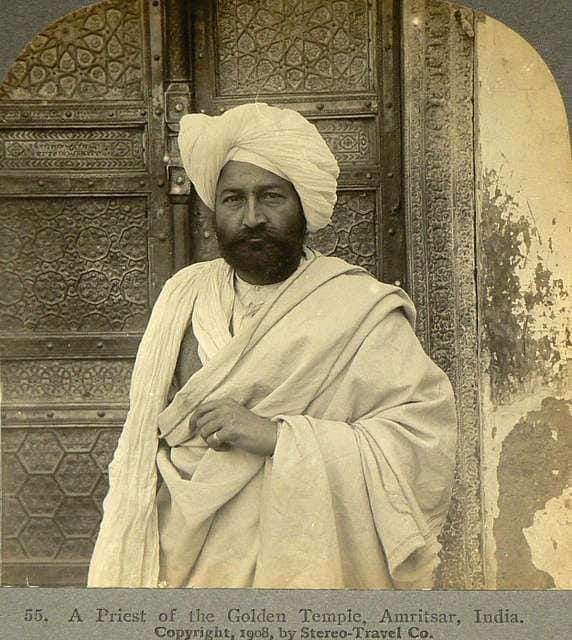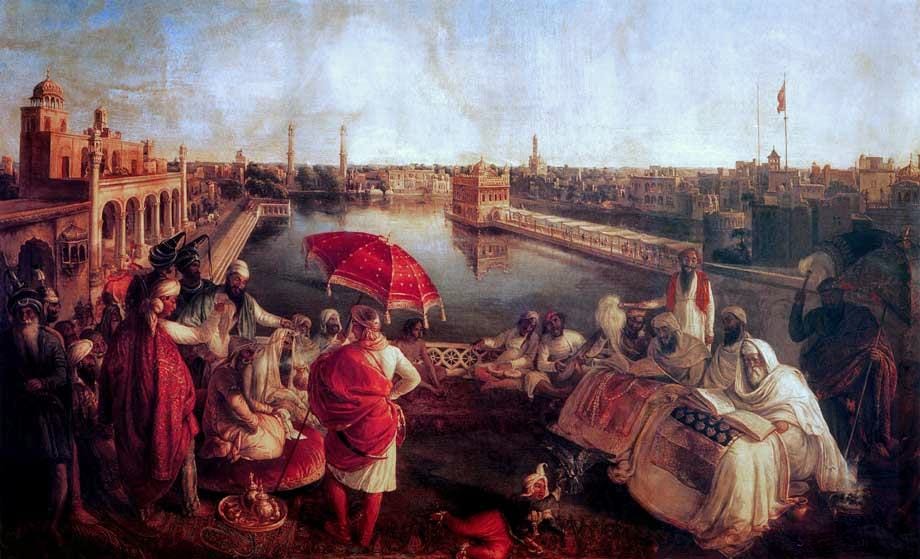The Origins of the Giani Samprada: Giani Surat Singh
The life and times of Giani Surat Singh at the dawn of Sikh Raj.
Editor’s note: This article forms a part of Khalsa Nama’s latest video release on the Origins of the Damdami Taksal, which can be found here:
You can also find a PDF file of lineage charts and other sources from within the video description itself.
“Highest of all, however, ranked the ‘Gyani’, the ‘Irfan’, who could explain the mysteries of philosophy and religion in popular language, and would communicate them, as a preacher, to the people, thus showing that the essence of Sikhism is the popularization of knowledge.”
Leitner, History of Indigenous Education In Panjab 1882
Giani Surat Singh and his descendants remain relatively obscure figures within contemporary Sikh thought. This family dominated at the heart of Harimandir Sahib, for 143 years, residing in the Giania Bunga1 (est. 1778) from the late eighteenth century up to 1921. Initially championed by the Misl Sardars, Giani Surat Singh and later his family earned further patronage from Maharaja Ranjit Singh and his successors due to their exceptional skill in their oral and written exegesis along with their distinctive capability to articulate Sikh teachings in simple and accessible language to the common person.
Giani Sant Singh (1768-1832), the son of Giani Surat Singh (d. 1804) took post following the death of his father, all but coinciding with consolidation of Maharaja Ranjit Singh’s rule in Amritsar at the turn of the nineteenth century. By this point, the Maharaja had already conferred the position of overall management of the Harimandir Sahib as hereditary. Giani Sant Singh performed Katha at the Katha Wala Bunga2 daily, joined military campaigns with the Maharaja earning him honourific jagirs3, and oversaw other administrative roles including the refurbishment of the complex with the addition of gold and marble. In fact all members of this family up to 1921, and the take over by the SGPC, were meticulous in their role in involving themselves in the up keep of Harimandir Sahib.4
“After Bhai Soorat Singh, Bhai Sant Singh began to perform Katha in Harmandir Sahib. Other than Bhai Sant Singh, no one else had permission to perform Katha in Harimandir Sahib. Katha would take place 4 Gharis (96 minutes) after midday.”
Report Sri Darbar Sahib
Crucially, the influence of the Giani family extended beyond their immediate family lineage. Through their teachings, conveyed in the form of master-student relationships, they cultivated a distinct school of thought that evolved into a recognised sect. The writings stemming from the Giani tradition played a fundamental role in shaping our understanding of Sikh theology.5
The line of transmission
18th-century literature provides scant information about Giani Surat Singh. The few contemporaneous mentions we currently possess are derived from his familial genealogy records in 1719 and 1784, likely during his pilgrimage to Hardiwar.6 Moving into the nineteenth century, following his death in 1804, several sources emerge connecting his spiritual lineage to the renowned Sikh martyr and head Granthi of Harimandir Sahib, Bhai Mani Singh (d. 1738).
Notable sources include: Bhai Visan Singh, a student under Giani Surat Singh [Gian Ratan Sagar Granth, 1828], Kavi Megh Singh, a student under Giani Sant Singh alongside Kavi Santokh Singh [Bhai Sahib Chandraka,1833], Ragi Sham Singh [Har Bhagat Prem Parkash], Kavi Nihal Singh [Kavit Bhedavali]. (Charts from other sources have been replicated in the PDF document for viewing)
There are also two undated uthankava of Guru Granth Sahib written in Braj which prominent scholars, Rattan Jaggi7 and Tirlochan Bedi8 associate to be the writings of a talented student under Bhai Mani Singh. They explicitly write of a ‘Giani Samparda’, with the teachings of the meanings of Guru Granth Sahib being passed on from Guru Gobind Singh to Bhai Mani Singh. We have not managed to locate dated sources in the eighteenth century of this tradition.
Giani Surat Singh
The birth date of Giani Surat Singh remains a subject of discrepancy in later sources. Contemporary records from Hardiwar indicate his presence in 1719, making certain a birth date prior to this.9 Ganesha Singh Bedi writing in the late 1800s, refrains from providing a specific birth date but attributes Surat Singh taking pahul directly from Guru Gobind Singh, and learning the meanings of Guru Granth Sahib from Bhai Mani Singh.10 Rattan Jaggi uses this account in his scholarship. Oberoi11 does not offer a specific birth date but draws upon ‘Chiefs and Families of Note in the Punjab’ suggesting that Surat Singh’s father, Ram Singh received Pahul from Guru Gobind Singh.
Surat Singh was a Khatri from Chiniot in the Jhang district of present-day Pakistan. The details on the life and movements of Surat Singh between 1719 and 1778 are scarce. S. S. Padam hints at a probable stint in government service in his youth, being of the educated elite and versatile in Persian, Sanskrit and Gurmukhi. This aligned with his great-grandfather, a prominent Diwan, a high-ranking finance minister in the Mughal ministry.
Griffin writes that similar to his father Ram Singh, Surat Singh was a zealous Sikh preacher around the Multan area and travelled around well beyond, proselytising Sikhi. Ram Singh is said to have earlier been in trouble with the Multan authorities for his preaching, which eventually led to him being courted for arrest, but it is said he escaped to Amritsar. His son Surat Singh, was thus taken into the service of the Multan governor, but before long, he too left for Amritsar. Ganesha Singh Bedi also writes of his move to Amritsar due to persistent Turkic invasions from the west.
Aina-i-Darbar12 suggests Surat Singh’s arrival in Amritsar by 1773 and is appointed for duty as the Head of Harimandir Sahib and patronised by the Misl Sardars, on the basis of his scholarly and preaching abilities. In the late 1800s, Giani Gian Singh13 suggests an earlier date of arrival in Amritsar in 1750. It’s unclear if he ever was in Amritsar prior to this, during the lifetime of Bhai Mani Singh.
Amidst the new construction works occurring around Harimandir Sahib from after 1764, a land grant is documented for Surat Singh’s building of the two storied Gianian Bunga between 1778-1783 for 4500 rupees.14 Griffin writes that he also acquired a small Jagir in the Jalandhar Doab where he built a fort, but died in Amritsar in 1804.15 Maharaja Ranjit Singh, having consolidated his rule around Amritsar by this time, first patronized Surat Singh in 1802, on his visit to Harimandir Sahib and conferred the management of Harimandir Sahib as hereditary. Surat Singh’s younger son Giani Sant Singh continued this family lineage on the passing of Surat Singh.16 There’s little known about his elder son Gurdas Singh, but he too features prominently amongst the lineage charts of the Gianis.
A Nirmala Connection
From the little we know about Giani Surat Singh’s life, beliefs and practices, there’s no literature suggesting that he was a Nirmala, nor do any traditional Nirmala lineage charts include him within their sphere. Extensive sources of the 19th century list him alongside Bhai Mani Singh within the lineage of the Gianis.
The families alleged links of emerging from the Nirmalas have historically been stressed by various groups. The most prominent of these included the Nirankari’s in a publication ‘Anand Viaha Di Ithahaska Kranti’ (1970). This was written by a descendant of Guru Dyal Singh, and not from the Sant Nirankari off-shoot sect. It included a publication on Giani Sant Singh, in which there’s a photo seen on the entrance of his residence featuring an idol of Ganesha. Interestingly, the publication draws upon the Ganesha idol to amplify Giani Sant Singh’s supposed Brahmanical influence. It notes that wedding ceremonies were only traditionally performed around the fire as they were influenced by the likes of Giani Sant Singh’s ideology. The Nirankaris thus reformed their Anand wedding, and had the bride and groom circumambulate Guru Granth Sahib instead.
Giani Gian Singh in his ‘Twarikh Sri Amritsar’17 claims that Giani Sant Singh was taught the Hanuman Natak and Adi Granth texts by Pandit Nihal Singh (the writer of a Japji Sahib and Ramayan steek). Giani Gian Singh, being of a Nirmala origin himself, necessitates caution over this information. No traditional lineage trees place Giani Sant Singh inside the Nirmala fold.
Literature has also continually placed Kavi Santokh Singh, the other student of Giani Sant Singh as a Nirmala, despite no evidence for this in his writings, and himself only claiming only a link to Giani Sant Singh.18
The writings of Giani Surat Singh
Of the corpus of literature attributed to Bhai Mani Singh, there have been strong scholarly claims for two of them being written by Giani Surat Singh: The Gyan Ratnavali (The Janamsakhi of Guru Nanak) and Sikhan Di Bhagatmala (Bhagat Ratnavali), expounding on the first and eleventh vaars of Bhai Gurdas. S.S. Padam, in the most recent scholarship, groups them both together and attributes them to Giani Surat Singh.19
In regards to the Gyan Ratnavali, there’s a scholarly consensus that this writing has not been produced by Bhai Mani Singh due to third person references inside this text. There is no name within the text confirming authorship. S.S. Padam, R. Jaggi, T. Bedi, H. McLeod, D. Chand M.A, J. Sabar, J. Singh have all attributed this text to Giani Surat Singh. K. Singh does not specify and Hans is the only scholar who attributes it to an Udasi writer.
The reference of Bhai Visan Singh from the Gian Ratan Sagar Granth (1828): ‘Mani Singh spoke, Gurbaksh Singh listened and Surat Singh wrote’, the Gurpranali of Sant Gulab Singh (1851) at the Shahid Bunga and textual references are used by scholars to attribute this to Giani Surat Singh. There’s a variance of dating around this production: S.S. Padam suggests a date between 1778-1783, during the time of the construction of the Giania Bunga, but this varies with some offering a dating of pre-1739. The main confusion lies in the dating of the ‘Gian Ratan Sagar’ text. Giani Garja Singh in ‘Shahid Bilas’ provides a date of 1739, which R. Jaggi (1995) uses but in newer scholarship, S.S. Padam refutes this and offers a date of 1828.
S S Padam, Sikhan Di Bhagatmala, 2013
Madanjit Kaur, The Golden Temple, Past & Present, 1993
Lepel Griffin, Chiefs and Families of Note in the Punjab, 1910
Madanjit Kaur, The Golden Temple, Past & Present, 1993
Surjit Hans, Encyclopaedia of Sikhism, 1961
S S Padam, Sikhan Di Bhagatmala, 2013
Rattan S Jaggi, Mani Singh Jiwan Ate Rachna, 1995
Tirlochan Singh Bedi, Sikhan Di Bhagatmala, 1986
S S Padam, Sikhan Di Bhagatmala, 2013
Surjit Hans, Encyclopaedia of Sikhism, 1961
Harjot Oberoi, Construction of Religious Boundaries, 1995
S S Padam, Sikhan Di Bhagatmala, 2013
Giani Gian Singh, Twarikh Sri Amritsar
S S Padam, Sikhan Di Bhagatmala, 2013
Lepel Griffin, Chiefs and Families of Note in the Punjab, 1910
S S Padam, Sikhan Di Bhagatmala, 2013
Tirlochan Singh Bedi, Sikhan Di Bhagatmala, 1986
Taran Singh, Gurbani Diyan Vaikhiyan Pranalian, 1980
S S Padam, Sikhan Di Bhagatmala, 2013





